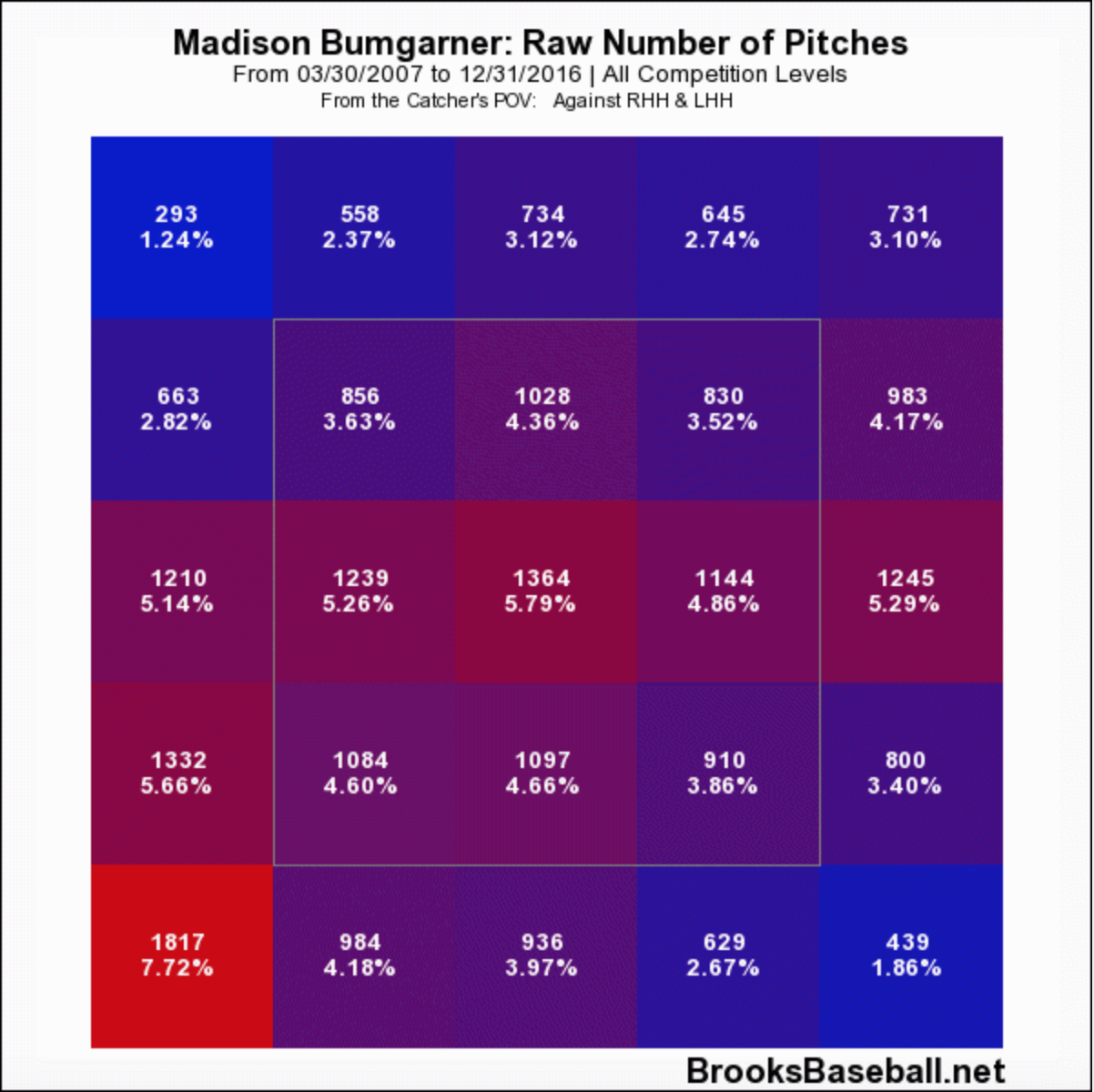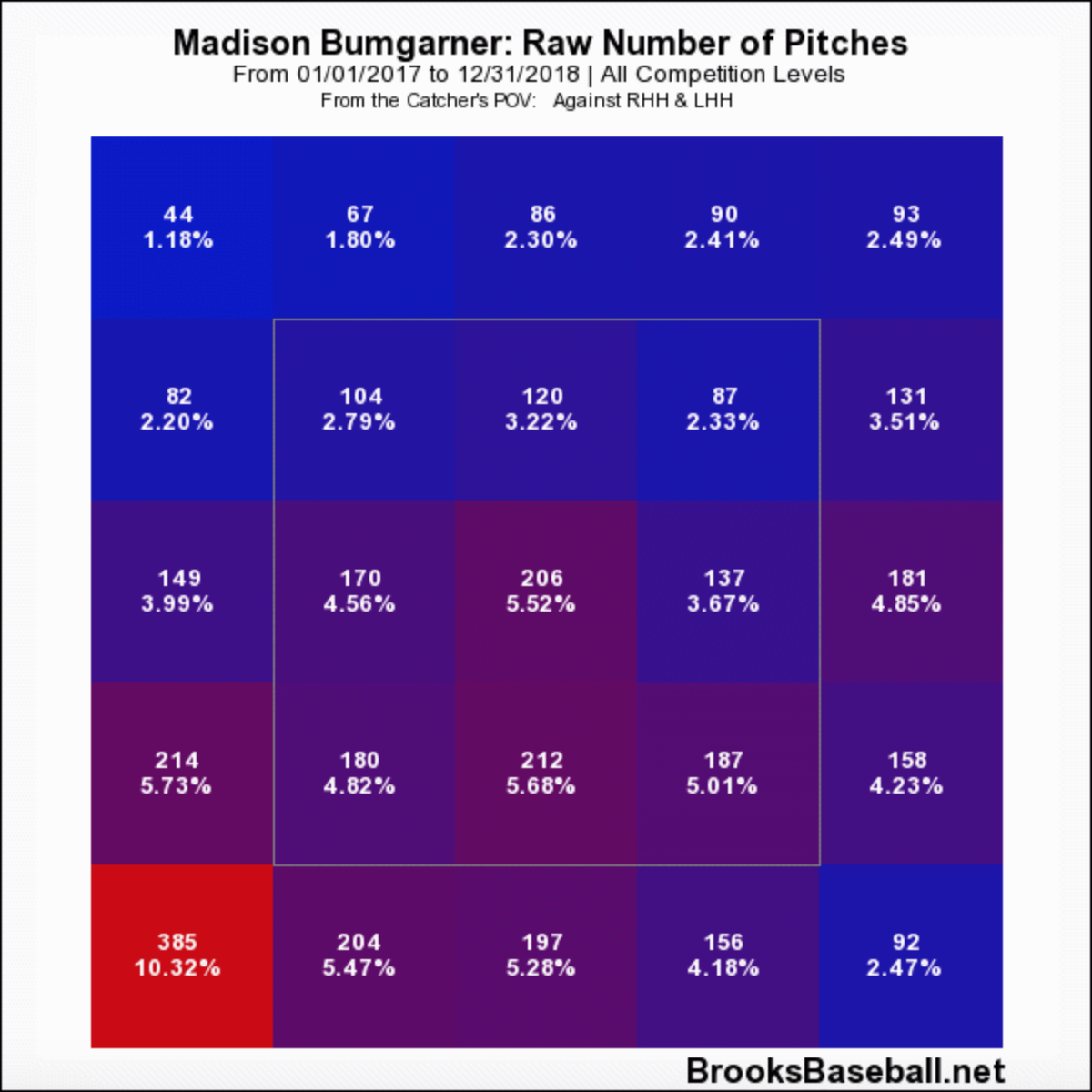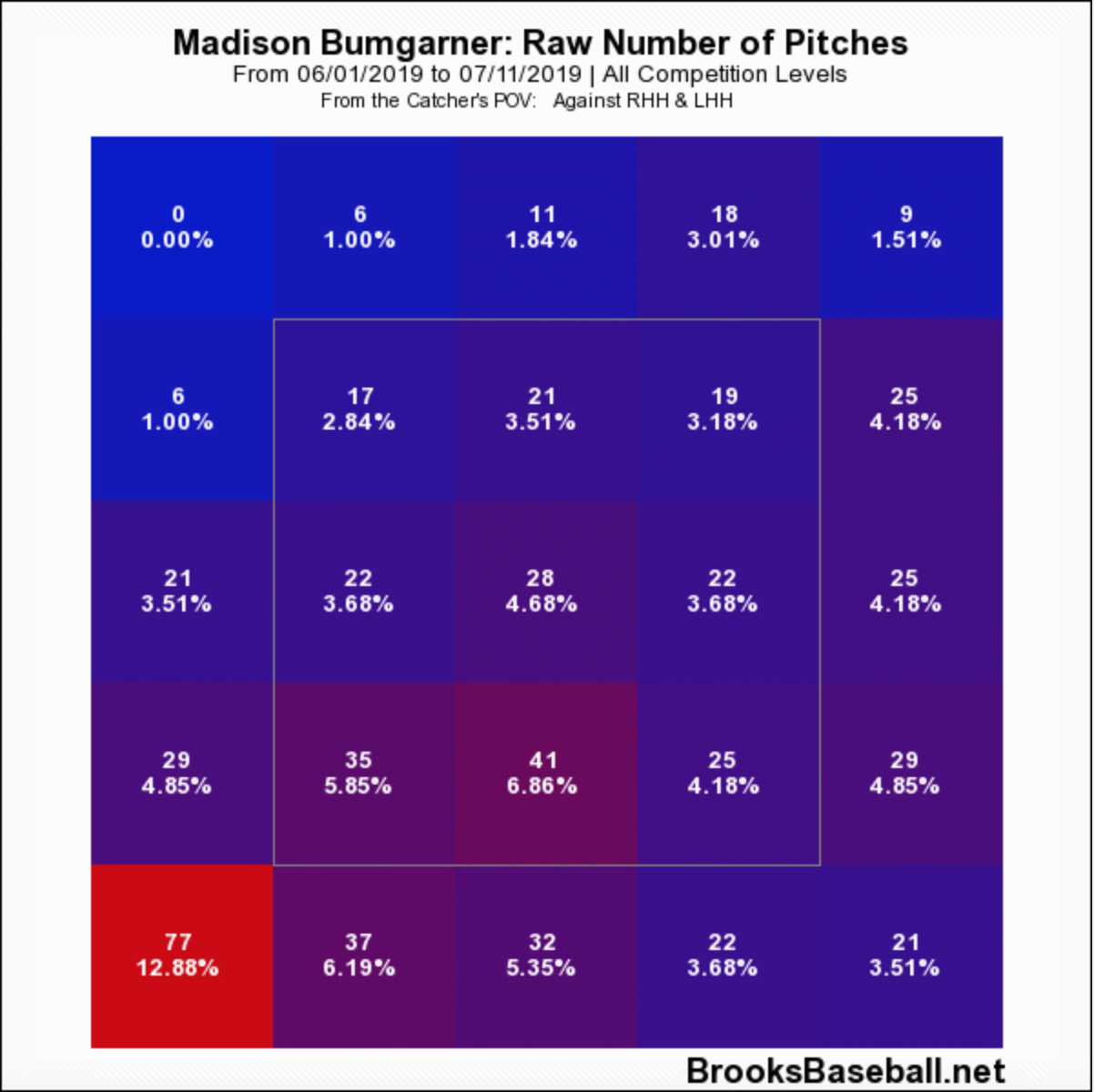Madison Bumgarner is one of your ‘old school’ hurlers. Built like an average overhead expressway, MadBum has gone out every fifth day, pitched deep into games, and not given any thought to a pitch count or any analytics. It’s worked for him, being the dominant force behind three championships for the San Francisco Giants over the past decade – particularly in 2014 when he pitched the most innings in a postseason ever.
As the years of high innings and pitch counts wore on, however, he became less effective with his skills deteriorating somewhat in 2016, before he decided to dirt bike during the season, taking out his pitching shoulder. Since that injury in early 2017, he’s not produced at the same level, with a higher ERA and a lower strikeout percentage than in his previous seasons.
This season it seems that he’s starting to resemble the same form he had prior to the injury with his velocity rebounding, adding one MPH on his four-seam fastball from last season, though his hard contact rate has increased to a career-high, above 45% according to Fangraphs – one of the worst rates in the majors. With a contrarian combination of crisper stuff and a higher hard hit percentage, we will take a look at what his impact might be when he is, more than likely, moved at the deadline.
The Glory Days
MadBum backed his rookie season in 2010 with big-time campaigns of 200+ innings of pure quality from 2011 to 2016. If that was not impressive enough, he also has an elite ERA of 2.11 in the postseason over 100 innings, none more remarkable than his 2014 October where he pitched 52.2 innings with a 1.03 ERA. As we reminisce over that campaign, I want you to notice catcher Buster Posey, where he’s setting up and how Bumgarner is hitting his spot.
The beauty of pitching is right there in those pitches. It’s an art form. The crossfire delivery, the pitch exploding from the hand and then hitting the catcher’s glove right in the webbing. In, out, up and down, Bumgarner was a master at manipulating the strike zone, allowing him to maneuver through lineups with minimal damage.
Rough Riding
In early 2017, Bumgarner thought dirt biking during the season was a great idea. It resulted in an injured pitching shoulder, thus derailing his 2017 campaign. He then fractured his pitching hand during Spring Training the following season. With a couple of injuries on his pitching arm, it was always going to be a tall order to come back and replicate what he had done.
Though for a pitcher with a sidearm delivery, that shoulder injury was the one that most likely affected him the most. His release point is fully extended away from his body, putting most of his control and velocity on the stability in his shoulder.
It should then be no surprise that his numbers were not nearly as good after the injury.
| ERA | K% | BB% | Hard Hit% | SIERA | |
| 2009-16 | 2.99 | 24.4 | 5.7 | 27.4 | 3.26 |
| 2017-18 | 3.29 | 21.0 | 6.3 | 38.6 | 4.20 |
To explain those diminished numbers, there are a couple of things we acknowledge. Firstly, let’s look at the location of his pitches.
The major difference here is the pitches at the top of the zone and to Bumgarner’s arm side of the plate. He threw a larger percentage of pitches at the top and inside to lefties prior to his shoulder injury than he did in the initial period post-injury. This allows the hitter to focus on one area of the plate, middle-in to righties in this case, rather than thinking about the entire plate, leading to a higher hard hit percentage.
Secondly, we notice the decrease in his four-seamer velocity and usage that occurred.
| Velocity | Usage% | Whiff% | Spin Rate | |
| 2010 | 91.3 | 38.2 | 13.6 | – |
| 2011 | 91.7 | 45.7 | 20.8 | – |
| 2012 | 91.1 | 27.9 | 17.4 | – |
| 2013 | 91.4 | 25.1 | 29.0 | – |
| 2014 | 92.1 | 37.6 | 25.6 | – |
| 2015 | 92.1 | 41.0 | 23.5 | 2315 |
| 2016 | 90.9 | 40.0 | 21.8 | 2303 |
| 2017 | 91.0 | 41.5 | 15.9 | 2166 |
| 2018 | 90.9 | 32.4 | 12.8 | 2082 |
The usage tells a more important story. Yes, his lowest four-seam fastball usage came from 2012-13, though he traded some of those four-seamers for sinkers, throwing the pitch about 16% and 14% of the time, respectively. These past couple of seasons he was throwing the pitch fewer than 2% of the time.
With a lack of overall fastball usage the past couple of seasons, there could be a multitude of issues, but none more important than the consequences of his injury. One particular issue could be the life of the pitch deteriorated, as the whiff and spin rates decreased the past two seasons. Another could have been psychological – lacking conviction for the pitch. If he still felt doubt over the health of his shoulder, he could very well have been holding back on his fastball rather than letting it fly.
The Now
With relatively low expectations this season, by his standards, Bumgarner had a lot to prove. There have been some highlights, but there have also been some fairly low points as well.
I’ve always been a positive guy, so let’s start with the good news.
To extend our previous tables, we will take a look at how he’s improved this season.
| ERA | K% | BB% | Hard Hit% | SIERA | |
| 2019 | 4.03 | 24.8 | 5.2 | 45.5 | 3.99 |
| Velocity | Usage% | Whiff% | Spin Rate | |
| 2019 | 91.7 | 43.5 | 21.3 | 2397 |
We can see that his K% went up and his BB% went down, both improvements over his previous two seasons. Most of that improvement can be attributed to his better four-seamer this season, backed by an increase in velocity and spin rate, thus yielding a higher whiff percentage.
With his four-seamer performing so well with increased usage, Bumgarner’s secondary pitches likely improved from hitters respecting the fastball more – being able to tunnel his cutter, curveball, and occasional changeups, from the fastball – leading to more strikeouts.
Though this is where we hit a snag. The elevated ERA and downright appalling Hard Hit% gives us a reason for concern, though there seems to be an explanation for this.
If we refer back to our previous charts with pitch locations, we were looking at how Bumgarner was less predictable prior to his injury than he was post-injury. If a pitcher is less predictable, it makes it tougher for the hitter to seek pitches out and drive them. For this season, he has become even more predictable than before.
A majority of the pitches can be charted middle-in to a right-handed hitter, where the predictability makes the job much easier for a hitter.
Then looking at his recent success in June, despite a blowup against the Los Angeles Dodgers, I wondered if he had made some improvements. The result was exactly what I was looking for.
Look at the diversity amongst the pitches. In, out, up and down, Bumgarner seems to have regained some of that pitching artistry I raved about in his 2014 postseason glory, though that has not given the results that I thought would come with his change in approach. His K/9 is nearly 10, but his ERA is still above four with an xFIP of nearly 4.50.
This was a rather odd discovery, where I thought if MadBum started pitching like he once did, it would give him that same success. If his location diversity was not a problem, it would then be worthwhile to revisit his pitch mix this season, compared to one of his better seasons, say 2014.
| FA | CT | CU | CH | SI | |
| 2014 | 37.6% | 26.2% | 14.0% | 7.6% | 8.5% |
| 2019 | 43.5% | 36.4% | 13.1% | 6.8% | 0.2% |
This season, Bumgarner is really only throwing four pitches – one of which is a changeup, that is hardly being used. With essentially only three pitches, they all have something in common – they do not break away from the right-handed hitter. With his changeup relatively falling by the wayside and his sinker not even being thrown now, this pitch mix could be the reason he’s still struggling. By increasing his changeup percentage, that added dimension of arm-side action could help him create even more doubt in the hitter’s mind.
Trade Season
Ken Rosenthal of the Athletic recently noted that four teams are interested in Bumgarner – the Atlanta Braves, Milwaukee Brewers, Minnesota Twins, and Houston Astros. With each of those four teams, there are potential benefits.
The Atlanta Braves are a fascinating young team that once again is leading the NL East, well on its way to defending its NL East crown. However, after losing in last year’s NLDS, they would certainly want to go deeper this time around. With Mike Soroka and Max Fried likely hitting innings limits as the season goes on, adding that Mike Foltynewicz and Kevin Gausman have been ineffective, Bumgarner fills an obvious hole in the rotation.
Though for Bumgarner, I am not sure what he potentially gains outside of being reenergized in the midst of a playoff run. While the Braves throw their fastballs at the highest rate in baseball, it is not a staff that throws their changeups often. Of course, the Braves might not have a team philosophy with their pitch mix like some teams do, but it would be beneficial if Bumgarner was forced to throw his changeup more often.
Next, the Milwaukee Brewers. The Brewers have similar usage numbers, with the second-highest fastball usage and a relatively low changeup percentage, but this would be a much better situation for Bumgarner. Recently, Milwaukee has been able to revive the careers of Wade Miley and Gio Gonzalez, Miley with his cutter and Gonzalez with his curveball – both pitches that Bumgarner throws. Miley and Gonzalez threw their most-effective pitches more with the Brew Crew than previously, so hopefully that infrastructure could help Bumgarner elevate the effectiveness of those pitches for more success.
The Minnesota Twins seem to offer Bumgarner the most potential success of all the four teams mentioned. The Twins are a top-10 team in changeup usage this season, a pitch Bumgarner should use more to gain that extra dimension to his repertoire. Though the best reason for him to end up with the Twins is the added velocity that their starters have gained on their fastballs this season. Look at the current Twins rotation and the gains that have been made with velocity.
| FA velocity 2018 | FA velocity 2019 | |
| Jose Berrios | 93.4 | 93.0 |
| Kyle Gibson | 93.1 | 93.4 |
| Jake Odorizzi | 91.1 | 92.8 |
| Michael Pineda | 93.9 (2017) | 92.6 |
| Martin Perez | 92.8 | 94.4 |
We will ignore Michael Pineda for the fact that he’s coming back from Tommy John surgery, making it difficult to tell whether moving to Minnesota truly changed his velocity. With Kyle Gibson, Jake Odorizzi, and Martin Perez, there were gains in fastball velocity, where we look no further than new pitching coach Wes Johnson. Jumping straight from college to the big leagues, Johnson has always been known as a magician of biomechanics. As Bumgarner is regaining the strength in his pitching shoulder, it would be incredibly beneficial for him to add some velocity to his fastball, making hitters make their decisions faster, thus making his secondary pitches that much more effective.
With the Astros, we already know what we are going to get. Added four-seamer spin rate, and an emphasis in throwing your best pitches more often, particularly breaking pitches. Bumgarner already has a great spin rate on his four-seamer, so the gains from that perspective would not be substantial. With Bumgarner’s curveball, the added usage could help him create a more diverse pitch mix compared to his more predominant usage of the four-seamer and cutter.
Now We Wait
Bumgarner is about to be set free from the only organization he has ever known, and likely be able to pitch in October once again. Even though his past two seasons have been subpar by his standards, we said the exact thing about Justin Verlander before he went to Houston. A title run can have that effect, raising your attention to the highest level – of course, that is not new to Bumgarner. With so much to be seen over the next couple of weeks heading into the deadline, don’t tell him to get [his career] out of the ocean just yet.
(Photo by Brian Rothmuller/Icon Sportswire)





